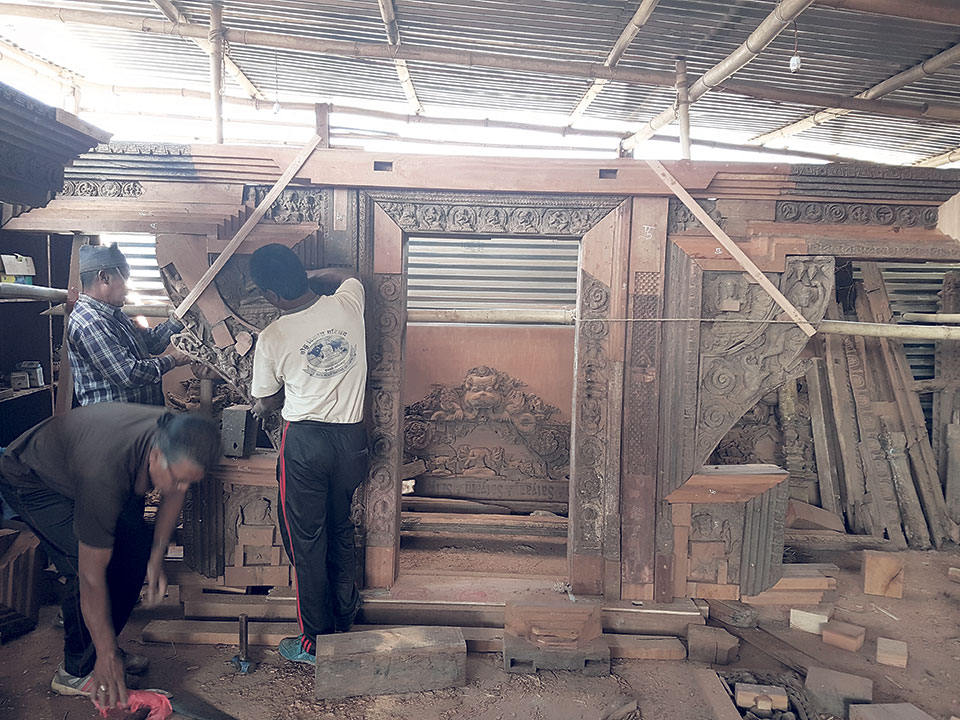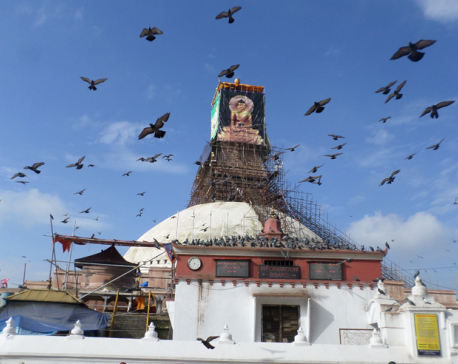
OR
Over 1,000 carpenters rejoice as reconstruction picks up
Published On: November 25, 2017 09:50 AM NPT By: Ayam Shrestha

KATHMANDU, Nov 24: Before the reconstruction of earthquake-damaged heritage began, Tirtha Ram Shilpakar’s days were spent in making small wooden handicraft for tourists. Rarely did he get to work on bigger projects. But as the work of reconstructing Patan Durbar Square has gathered pace, his schedule has changed drastically.
Shilpakar now rises with the sun at six and rides his bike to his workshop at Bhandarkhal Chowk, Patan from his residence at Siddha Pokhari, Bhaktapur.
At his workshop, he has been working on replicating the architectural masterpiece of the demolished Harishankar Temple built during the reign of King Yognarendra Malla (1684-1705) of Patan. Shilpakar, who now receives a daily wage of Rs 1,500, said: “As carved furniture costs extravagantly high, besides a prolonged production time compared to modern furniture, these have not been in popular demand. However, now with the restoration process underway, work has become plentiful.”
This is not just the story of Tirtha Ram but that of more than 1,000 wood workers who earn their daily bread and bread through carpentry, particularly Patan, Bungamati, Kirtipur, Bhaktapur, and Basantapur areas of Kathmandu valley.
“The past year has been wonders for us. Prior to being chosen to help restore the temple of Rato Machhindranath, we rarely worked regularly. Our days used to be spent on agriculture or making small wooden windows,” said Shanta Raj Tuladhar of Bungamati-10, Karyabinayak. “We usually sold small handicrafts to tourists before. However, even though the influx of tourist has decreased dramatically, we had never seen an increase in income before.”
Tuladhar exports his handicrafts to Germany, France, Belgium, Italy, and Spain along with the US and the UK.
Talking with Republica, Jaya Narayan Karki, chief of Hanuman Dhoka Museum, stated: “Carpenters of various places in the valley, most prominently in Bungamati and Bhaktapur, are in luck. Additionally, wood carving is being held here in the courtyards of Basantapur Durbar and also in Patan.”
“Seventy workers are busy for the reconstruction of Nau Talle Durbar alone, in which we are seeking to add additional workers,” Karki added.
Nau Talle Durbar -- the majestic nine-storied palace of Basantapur Durbar Square -- is a masterpiece of Nepalese architecture which served as the Royal Palace following the annexation of Kathmandu valley to the kingdom of Gorkha in 1768 AD. The palace that was heavily devastated by the 2015 earthquake is being reconstructed with support from the Government of China.
“The cost cannot be estimated as we cannot be sure about the condition of internal structure of the palace. However, it is expected to be complete within the next five years,” explained Karki.
“Wood carving is a major occupation for the inhabitants of Bungamati. We can safely say that at least one in each family has been involved in carpentry,” said Sunil Maharjan, ward secretary of Bungamati Rural Municipality-10. The reconstruction of the Rato Machhindranath Temple is also taking place in Bungamati, a village in the outskirts of Kathmandu valley with the assistance of the Government of Sri Lanka.
“The reconstruction and restoration project of the Rato Machhindranath Temple has employed around 30 workers, almost half of whom are carpenters,” said Amrit Lal Shrestha, supervisor of the Rato Machchindranath Temple Reconstruction Project.
“Although we only have experienced wood-workers, carpentry has been a major attraction among the inhabitants of Bungamati and Khokana. Such wood workers earn on the basis of their skill and experience. Experienced and skilful workers may earn up to Rs 2,500 to Rs 3,000 a day. Those who are new may earn between Rs 1,000 to Rs 1,200.”
“About 60 - 70 workers have been working under Kathmandu Valley Preservation Trust (KVPT) for the renovation of Kathmandu Durbar Square alone, more than half of whom are involved in carpentry,” said Dr Rohit Ranjitkar, director of KVPC.
“Although employment among the wood workers has increased, KVPT has not been able to work at its full capacity as we have not been able to find adequate human resources. Families who used to produce handicraft ancestrally have diverted into other professions, which may have contributed to the lack of skilled manpower,” added Ranjitkar.
The reparation cost of the disaster is estimated to be Rs 16.91 billion according to Post Disaster Needs Assessment, published by the National Planning Commission. Currently, wood carvers have been banking between Rs 25,000 to Rs 75,000 monthly by working for the restoration of lost monuments. Wood carving is an art inherited by the Newar community of Kathmandu valley for centuries among.
You May Like This

Reconstruction finally picks up pace after 32 months of earthquake
SINDHULI, Dec 29: Thirty-two months after the catastrophic earthquake of 2015, reconstruction has finally been speeded up in Sindhuli. ... Read More...

China provides nearly Rs 16 billion grants for reconstruction
KATHMANDU, Dec 11: The Chinese government has provided nearly Rs 16 billion for the post-quake reconstruction activities in Nepal. ... Read More...

30 kg gold used for Boudhanath Stupa reconstruction
KATHMANDU, Aug 28: The reconstruction of the Boudhanath stupa which was completely damaged by the devastating earthquake on 25th of... Read More...




Just In
- Govt receives 1,658 proposals for startup loans; Minimum of 50 points required for eligibility
- Unified Socialist leader Sodari appointed Sudurpaschim CM
- One Nepali dies in UAE flood
- Madhesh Province CM Yadav expands cabinet
- 12-hour OPD service at Damauli Hospital from Thursday
- Lawmaker Dr Sharma provides Rs 2 million to children's hospital
- BFIs' lending to private sector increases by only 4.3 percent to Rs 5.087 trillion in first eight months of current FY
- NEPSE nosedives 19.56 points; daily turnover falls to Rs 2.09 billion















Leave A Comment